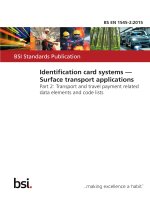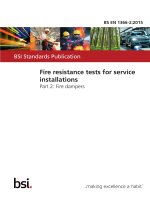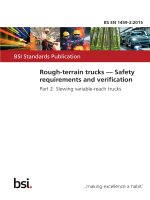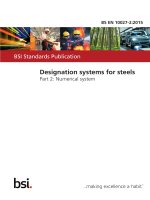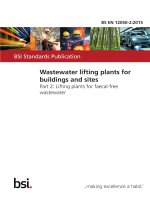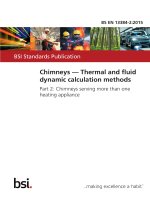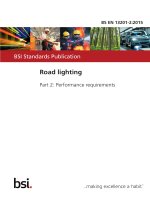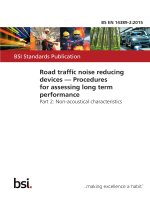Bsi bs en 01253 2 2015
Bạn đang xem bản rút gọn của tài liệu. Xem và tải ngay bản đầy đủ của tài liệu tại đây (1.26 MB, 40 trang )
BS EN 1253-2:2015
BSI Standards Publication
Gullies for buildings
Part 2: Roof drains and floor gullies without
trap
BS EN 1253-2:2015
BRITISH STANDARD
National foreword
This British Standard is the UK implementation of EN 1253-2:2015.
This document, together with BS EN 1253-1:2015, supersedes BS EN
1253-1:2003 and BS EN 1253-2:2003, which are withdrawn.
The UK participation in its preparation was entrusted to Technical
Committee B/505, Wastewater engineering.
A list of organizations represented on this committee can be
obtained on request to its secretary.
This publication does not purport to include all the necessary
provisions of a contract. Users are responsible for its correct
application.
© The British Standards Institution 2015. Published by BSI Standards
Limited 2015
ISBN 978 0 580 78398 2
ICS 91.140.80
Compliance with a British Standard cannot confer immunity from
legal obligations.
This British Standard was published under the authority of the
Standards Policy and Strategy Committee on 31 January 2015.
Amendments issued since publication
Date
Text affected
BS EN 1253-2:2015
EN 1253-2
EUROPEAN STANDARD
NORME EUROPÉENNE
EUROPÄISCHE NORM
January 2015
ICS 91.140.80
Supersedes EN 1253-1:2003, EN 1253-2:2003
English Version
Gullies for buildings - Part 2: Roof drains and floor gullies without
trap
Avaloirs et siphons pour bâtiments - Partie 2 : Avaloirs de
toiture et avaloirs/siphons de sol sans garde d'eau
Abläufe für Gebäude - Teil 2: Dachabläufe und
Bodenabläufe ohne Geruchverschluss
This European Standard was approved by CEN on 22 November 2014.
CEN members are bound to comply with the CEN/CENELEC Internal Regulations which stipulate the conditions for giving this European
Standard the status of a national standard without any alteration. Up-to-date lists and bibliographical references concerning such national
standards may be obtained on application to the CEN-CENELEC Management Centre or to any CEN member.
This European Standard exists in three official versions (English, French, German). A version in any other language made by translation
under the responsibility of a CEN member into its own language and notified to the CEN-CENELEC Management Centre has the same
status as the official versions.
CEN members are the national standards bodies of Austria, Belgium, Bulgaria, Croatia, Cyprus, Czech Republic, Denmark, Estonia,
Finland, Former Yugoslav Republic of Macedonia, France, Germany, Greece, Hungary, Iceland, Ireland, Italy, Latvia, Lithuania,
Luxembourg, Malta, Netherlands, Norway, Poland, Portugal, Romania, Slovakia, Slovenia, Spain, Sweden, Switzerland, Turkey and United
Kingdom.
EUROPEAN COMMITTEE FOR STANDARDIZATION
COMITÉ EUROPÉEN DE NORMALISATION
EUROPÄISCHES KOMITEE FÜR NORMUNG
CEN-CENELEC Management Centre: Avenue Marnix 17, B-1000 Brussels
© 2015 CEN
All rights of exploitation in any form and by any means reserved
worldwide for CEN national Members.
Ref. No. EN 1253-2:2015 E
BS EN 1253-2:2015
EN 1253-2:2015 (E)
Contents
Page
Foreword ..............................................................................................................................................................3
1
Scope ......................................................................................................................................................4
2
Normative references ............................................................................................................................4
3
Terms and definitions ...........................................................................................................................4
4
4.1
4.2
4.3
4.4
4.5
4.6
4.7
Requirements .........................................................................................................................................9
Design and construction .......................................................................................................................9
Places of installation .......................................................................................................................... 10
Materials .............................................................................................................................................. 11
Watertightness .................................................................................................................................... 11
Mechanical strength ........................................................................................................................... 11
Flow rates ............................................................................................................................................ 11
Additional requirements in relation to the installation ................................................................... 13
5
5.1
5.2
5.3
5.4
5.5
5.6
5.7
5.8
5.9
Test methods....................................................................................................................................... 15
Dimensions of apertures in gratings ................................................................................................ 15
Water tightness for roof drain and floor gully bodies and extensions ......................................... 15
Loading test ......................................................................................................................................... 15
Mechanical strength ........................................................................................................................... 19
Flow rates ............................................................................................................................................ 20
Tightness of roof drains and floor gullies for use with sheet floor coverings, membranes
or liquid applied membranes ............................................................................................................. 30
Behaviour when exposed to hot bitumen or asphalt ...................................................................... 31
Determination of resistance in climatic influences ......................................................................... 31
Temperature cycling test ................................................................................................................... 32
6
Allocation and sequence of tests...................................................................................................... 32
7
Marking ................................................................................................................................................ 32
8
Evaluation of conformity .................................................................................................................... 33
Annex A (normative) Sequence of the tests .................................................................................................. 34
Annex B (informative) A-deviation.................................................................................................................. 35
Bibliography ..................................................................................................................................................... 36
2
BS EN 1253-2:2015
EN 1253-2:2015 (E)
Foreword
This document (EN 1253-2:2015) has been prepared by Technical Committee CEN/TC 165 “Waste water
engineering”, the secretariat of which is held by DIN.
This European Standard shall be given the status of a national standard, either by publication of an identical
text or by endorsement, at the latest by July 2015 and conflicting national standards shall be withdrawn at the
latest by July 2015.
Attention is drawn to the possibility that some of the elements of this document may be the subject of patent
rights. CEN [and/or CENELEC] shall not be held responsible for identifying any or all such patent rights.
This document, together with EN 1253-1:2015, supersedes EN 1253-1:2003 and EN 1253-2:2003.
This is the second part in EN 1253, a series of standards relating to floor gullies, roof drains and access
covers for drainage systems inside buildings. The EN 1253 series under the main title Gullies for buildings will
actually consist of the following parts:
—
Part 1: Trapped floor gullies with a depth of water seal of at least 50 mm;
—
Part 2: Roof drains and floor gullies without trap;
—
Part 3: Evaluation of conformity;
—
Part 4: Access covers;
—
Part 5: Gullies with light liquids closure.
Since the latest versions of EN 1253-1 and EN 1253-2 the most significant technical changes are the
following:
a)
reduction of scope on roof outlets and floor gullies without trap including parapet and emergency drains
for use in gravity and siphonic drainage systems;
b)
more definitive description of products;
c)
modification of terms and definitions;
d)
precision in definition of places of installation;
e)
consideration of liquid applied membranes as connecting components;
f)
precision of test conditions for flow rate testing for different types of products;
g)
revision of loading test concerning test loads, loading speed as well as shape, size and point of impact of
test blocks in dependence on different configuration of gratings;
h)
introduction of classification of products concerning their temperature cycling behavior according to
number of hot/cold water cycles.
According to the CEN-CENELEC Internal Regulations, the national standards organizations of the following
countries are bound to implement this European Standard: Austria, Belgium, Bulgaria, Croatia, Cyprus, Czech
Republic, Denmark, Estonia, Finland, Former Yugoslav Republic of Macedonia, France, Germany, Greece,
Hungary, Iceland, Ireland, Italy, Latvia, Lithuania, Luxembourg, Malta, Netherlands, Norway, Poland, Portugal,
Romania, Slovakia, Slovenia, Spain, Sweden, Switzerland, Turkey and the United Kingdom.
3
BS EN 1253-2:2015
EN 1253-2:2015 (E)
1
Scope
This European Standard classifies roof drains and floor gullies without trap for use inside buildings, gives
guidance for places of installation and specifies requirements for the construction, design, performance and
marking as well as test methods of factory made roof drains and floor gullies without trap (further: floor gullies)
for buildings, irrespective of the material for use in drainage systems.
Although normally used to convey rainwater and wastewater, these roof drains and floor gullies without trap
may convey other wastewater provided there is no risk of damage to components or of injury to health.
This European Standard does not apply to trapped floor gullies with a depth of water seal of at least 50 mm as
specified in EN 1253-1.
2
Normative references
The following documents, in whole or in part, are normatively referenced in this document and are
indispensable for its application. For dated references, only the edition cited applies. For undated references,
the latest edition of the referenced document (including any amendments) applies.
EN 124, Gully tops and manhole tops for vehicular and pedestrian areas — Design requirements, type testing,
marking, quality control
EN 476, General requirements for components used in drains and sewers
EN 1253-3, Gullies for buildings — Part 3: Evaluation of conformity
3
Terms and definitions
For the purposes of this document, the following terms and definitions apply.
3.1
roof drain
non-trapped discharge fitting for the drainage of surface water from roof, balcony and terrace surfaces via a
rainwater connecting pipe
Note 1 to entry:
See Figure 1.
Note 2 to entry:
A roof drain can include an anti-vortex device.
3.2
parapet drain
roof drain for the drainage of flat roofs and roof terraces with a fascia which penetrates the fascia
Note 1 to entry:
See Figure 2.
3.3
emergency drain
roof drain for emergency drainage in the form of a roof, parapet or gutter outlet with or without a rainwater
connection pipe
4
BS EN 1253-2:2015
EN 1253-2:2015 (E)
Key
1
grating/frame, leaf/gravel trap
2
liquid applied roof waterproofing kit or flexible sheet for waterproofing
3
extension
4
seal
5
connecting flange
6
body
7
outlet
Figure 1 — Roof drain (example)
5
BS EN 1253-2:2015
EN 1253-2:2015 (E)
Key
1
grating
2
body
3
connecting flange
4
liquid applied roof waterproofing kit or flexible sheet for waterproofing
5
outlet (round or rectangular)
Figure 2 — Parapet drain (example)
3.4
gravity drainage system
system where flow is caused by gravity and where the pipe normally operates partially full
3.5
siphonic drainage system
system for drainage of rainwater in which the outlets and pipework enable the system to flow completely full
under design conditions and make use of the total height available between the outlets and the point of
change to partially filled flow
3.6
head of water
depth h of a water line over the spill edge of the roof drain or floor gully as shown in Figure 3
Key
h
head of water
Figure 3 — Head of water
3.7
grating
removable component with apertures which permit the discharge of water
6
BS EN 1253-2:2015
EN 1253-2:2015 (E)
3.8
frame
support for a grating or cover which is connected to a body either directly or by means of a flexible sheet for
waterproofing clamping ring or an extension
3.9
cover
removable part of an access cover which covers the opening
3.10
body
part of a roof drain or floor gully below or in the floor, ground or roof on which the grating/frame/extension is
mounted, and to which the pipework is connected
3.11
extension
component used to adjust the height of a grating or cover above a body
3.12
joint
connection between the adjacent ends of two components including the means of sealing
3.13
flexible sheet for waterproofing clamping ring
component used to clamp a flexible sheet for waterproofing to a body or extension
3.14
connecting flange
separate or an integral part of a body or of an extension which receives a flexible sheet for waterproofing or
the liquid applied roof waterproofing kit
3.15
external diameter
OD
mean external diameter of the pipe barrel at any cross section
3.16
internal diameter
ID
mean internal diameter of the pipe barrel at any cross section
3.17
liquid applied roof waterproofing kit
LARWK
particular combination of a defined set of components to be installed in liquid form for roof waterproofing by
application and/or incorporation and/or joining of the components in accordance with particular design
methods
Note 1 to entry:
The liquid applied watertight covering is usually a paste-like composite material or a combination of
separate materials that can be poured, spread or sprayed on the subsurface by brush, roller or similar suitable applicator.
3.18
flexible sheet for waterproofing
factory made sheet for prevention of passage of water from the plane to another which can be rolled up or
folded for easy transport to the site
7
BS EN 1253-2:2015
EN 1253-2:2015 (E)
3.19
untrafficked roof
roof consisting of the structural deck and all the layers on it, including waterproofing, insulation and a surface
protective layer not designed for foot traffic above that required for maintenance
3.20
pedestrian access roof
roof consisting of the structural deck and all the layers on it, including waterproofing, insulation and a surface
protective layer designed for foot traffic and gathering of people greater than that required for maintenance
3.21
green roof
roof consisting of the structural deck and all the layers on it, including waterproofing, insulation and a thin layer
of growing medium planted with vegetation
3.22
roof garden
roof consisting of the structural deck and all the layers on it, including waterproofing, insulation and a
substantial layer of growing medium planted with intensive vegetation and possibly paving
3.23
parking deck
roof consisting of the structural deck and all the layers on it, including waterproofing, insulation and a surface
protective layer designed to withstand and distribute loads produced by the traffic associated with the parking
of vehicles
3.24
nominal size
DN
numerical indication of size which is a convenient integer approximately equal to the internal diameter (DN/ID)
or the external diameter (DN/OD) in millimetres
3.25
floor gully without trap
discharge fitting the top of which is a grating or cover capable of installation at ground or floor level intended to
receive wastewater through apertures in the grating
Note 1 to entry:
See Figure 4.
Key
1
2
3
grating
outlet
body
Figure 4 — Floor gully without trap (typical example)
8
BS EN 1253-2:2015
EN 1253-2:2015 (E)
3.26
wastewater
water composed of any combination of water discharged from domestic, industrial or commercial premises,
surface run-off and accidentally any sewer infiltration water
[SOURCE: EN 16323:2014, 2.3.10.65]
3.27
surface water
water from precipitation, which has not seeped into the ground and is discharged to the drain or sewer system
directly from the ground or from exterior building surfaces
[SOURCE: EN 16323:2014, 2.1.1.3]
3.28
clear opening
CO
diameter of the largest circle that can be inscribed within the unsupported area of the grating
3.29
test load
specified load which a component is required to withstand
3.30
outlet
male or female connection to the drainage pipe
4
Requirements
4.1
4.1.1
Design and construction
General
Roof drains and floor gullies shall be capable of being connected to the pipework system covered by relevant
European Standards, and, when installed in accordance with the manufacturer's instructions, shall form an
integral part of the building. There shall be no movement possible between the roof drain or floor gully and the
floor or roof construction, which would impair the functioning of the installed roof drain or floor gully.
The upper surfaces of frame and grating shall be flush, except in untrafficked roof. When in position, it shall
not be possible for gratings and covers to be dislodged from the frame, but they shall be easy to remove for
maintenance and cleaning.
Roof drains and floor gullies shall be delivered with installation instructions.
All pipe joints to and from the roof drain or floor gully shall be designed to be watertight in accordance with
EN 476.
4.1.2
Appearance
Internal and external surfaces shall be free from sharp edges and imperfections which could impair functioning
of the gully or give risk of injury.
4.1.3
Apertures in gratings
Apertures can be holes or slots of any shape.
9
BS EN 1253-2:2015
EN 1253-2:2015 (E)
When measured in accordance with 5.1, the permissible aperture dimensions for gratings are given in
Table 1.
Table 1 — Apertures in gratings
Class
Dimensions of apertures in gratings
Minimum width
mm
H
K
L
R
M
N
P
a
b
b
1,5
3
a
15
a
50
a
125
250
400
4
b
4
4
4
4
4
4
Maximum width
mm
15 (max. 8 mm in barefoot areas)
10 (max. 8 mm in barefoot areas)
15 (max. 8 mm in barefoot areas)
25 (max. 8 mm in barefoot areas)
25
25
25
In commercially used premises, gratings may also be used with a maximum width of apertures up to 31 mm.
Apertures of less than 4 mm width are permitted and shall not form part of the hydraulic tests.
Gratings for installation in untrafficked roof shall project not less than 30 mm above the roof covering. If the
height of any subsequent surfacing cannot be specified, the grating shall project not less than 70 mm above
the connecting surfaces.
NOTE
If necessary, appropriate means can be provided to prevent the ingress of fine particles such as gravel into a
roof drain.
4.2
Places of installation
4.2.1
General
A guide for selecting the class of roof drains and floor gullies appropriate to the place of installation is given
below. The selection of the appropriate class is the responsibility of the specifier.
a)
Class H 1,5: Untrafficked roof such as felt-and-gravel roofs, gravel fill roofs and similar.
b)
Class K 3:
c)
Class L 15: Areas with light vehicular traffic such as in commercially used premises and public areas.
d)
Class R 50: Areas with vehicular traffic, such as in commercially used premises and factories.
e)
Class M 125: Areas with vehicular traffic, such as parking decks, factories and workshops.
f)
Class N 250: Heavy duty industrial areas subject to fork lift traffic.
g)
Class P 400: Extra-heavy duty applications where gullies are subjected to industrial fork lift trucks and/or
where heavy vehicles are manoeuvring.
Areas without vehicular traffic, such as dwellings, commercial and some public buildings.
Classes E 600 and F 900 gully tops conforming to EN 124 may be used for all areas subject to special
stresses such as exhibition halls, market halls, factory sheds and aircraft hangars.
10
BS EN 1253-2:2015
EN 1253-2:2015 (E)
4.2.2
Exceptions
Non-load bearing gratings for places of installation which are not accessible to vehicles and pedestrians
(protected by suitable masonry surroundings) and which are not covered by the places of installation listed
above nor by EN 124 shall at least conform to the test requirements given in 5.3, Class H 1,5.
4.3
Materials
Materials for roof drains shall be resistant to rainwater, UV radiation, local climatic conditions and, if required,
to hot bitumen.
Materials for floor gullies shall withstand a maximum intermittent wastewater temperature of 95 °C.
Materials shall withstand the stresses likely to occur during installation and operation.
Roof drains and floor gullies made of materials which are not inherently corrosion-resistant shall be protected
by corrosion prevention treatment.
For industrial wastewater applications, the chemical compatibility and exposure to continuous elevated
temperatures of materials with the transported fluids should be determined separately between the specifier
and the manufacturer.
4.4
4.4.1
Watertightness
Watertightness for bodies
No leaks shall occur when tested in accordance with 5.2.
4.4.2
Watertightness of joints for extensions
Where the situation dictates watertightness between extension and body (typical exception, e.g. green roofs,
inverted roofs), the joint between the extension and the body shall be watertight when tested in accordance
with 5.2.
4.5
4.5.1
Mechanical strength
Loading strength
Roof drains and floor gullies and/or gratings are classified by loading strength, when tested in accordance with
5.3, into the following classes: H 1,5, K 3, L 15, R 50, M 125, N 250, P 400.
Roof drains and floor gullies not accessible to either vehicular or foot traffic or not required to withstand
external loads are not classified.
4.5.2
Clamping ring
When tested in accordance with 5.4, the clamping ring shall not change its position and shall not show any
damage after testing that impairs function.
4.6
4.6.1
Flow rates
Floor gullies
When tested in accordance with 5.5.1, floor gullies shall be capable of discharging at flow rates given in
Table 2.
11
BS EN 1253-2:2015
EN 1253-2:2015 (E)
Table 2 — Minimum flow rates for floor gullies
Nominal size of outlet
a
Floor gullies
(qgrate)
DN/OD
DN/ID
32
Head of water h
l/s
mm
0,4
30
40
0,4
0,6
40
50
0,6
0,8
50
0,8
63
0,8
75
0,8
70
0,8
75
0,8
90
0,8
100
1,4
100
20
1,4
110
1,4
125
2,8
125
2,8
150
4,0
160
a
Minimum flow rate
4,0
All dimensions not mentioned in this table shall be tested with the next higher dimension.
4.6.2
Roof drains or parapet drains
The manufacturer shall state the flow rates of the roof drains or parapet drains as a function of the head of
water in a table or a diagram. The tests shall be performed in accordance with 5.5.2 and 5.5.3 and in
accordance with the manufacturer's installation instructions. The tests are considered to be passed, if the
values given in Table 3 are met.
Parapet drains can be non-piped (spouts) or piped in the form of a drainage system.
12
BS EN 1253-2:2015
EN 1253-2:2015 (E)
Table 3 — Minimum flow rates for roof drains
Nominal size of roof spigot
DN/OD
DN/ID
Gravity drainage
Minimum flow
rate
Head of water h
Minimum flow
rate
Head of water h
l/s
mm
l/s
mm
—
—
40
40
50
50
63
75
70
80
75
90
110
100
125
125
160
150
4.6.3
Siphonic drainage
2,5
3,0
4,0
0,9
6,0
1,0
7,0
1,7
12,0
55
35
2,6
14,0
3,0
18,0
4,5
22,0
7,0
45
—
—
8,1
Roof drains and parapet drains for siphonic drainage
Roof drains and parapet drains shall be suitable for roof drainage systems intended to be operated in a fully
filled state. The flow rates and the single resistor coefficient shall be determined in accordance with 5.5.4.2
and be stated by the manufacturer.
When tested in accordance with 5.5.4, roof drains and parapet drains shall be capable of achieving the
minimum flow rates given in Table 3.
4.6.4
Coefficient of hydraulic loss
For designing a siphonic drainage system, the coefficient of hydraulic loss of the complete ready-for-use roof
drain with and without extensions shall be determined in accordance with 5.5.4.3.
4.7
4.7.1
Additional requirements in relation to the installation
Roof drains and floor gullies for use with a membrane
Roof drains and floor gullies for use with a membrane shall be fitted with a connecting flange in accordance
with Table 4.
13
BS EN 1253-2:2015
EN 1253-2:2015 (E)
Table 4 — Connecting flanges
Minimum effective flange width
mm
Type of seal in flange area
Connecting flange with counterflange
Fixed
a
Loose
Flange for
bonding
Flange for
welding
Bitumen covering
—
bonded
—
—
100
—
—
clamped
70
60
—
—
—
Membranes manufactured
from plastics or elastomers
—
attached with adhesive
—
—
30
—
—
clamped
50
40
—
—
—
welded on membrane
—
—
—
50
—
LARWK
—
—
30
—
a
This value is also applicable to gullies fitted with a skirt membrane at the manufacturer's works.
Roof drains for use with a membrane shall be fitted with a sealing flange in accordance with Table 4 and/or
with a membrane clamping ring and shall be tight when tested in accordance with 5.6.
For floor gullies where a clamping ring without weep holes is used, the connection of a flange shall be tight
when tested in accordance with 5.6.
When tested in accordance with 5.4.2, there shall be no peeling at ≤ 100 N.
4.7.2
Behaviour when exposed to hot bitumen or asphalt
Roof drains and floor gullies in direct contact with hot bitumen or poured asphalt shall be resistant up to a
temperature of (220 ± 5) °C when tested in accordance with 5.7. This requirement is considered to be met for
roof drains with factory fixed bitumen membranes and for gullies made exclusively of metal.
4.7.3
Resistance to climatic influences
Roof drains and their components shall be resistant to climatic influences. They shall be frost resistant to
−20 °C and heat resistant up to 80 °C when tested in accordance with 5.8.
4.7.4
Resistance to thermal cycling
When tested in accordance with 5.9, floor gullies and their components shall show no deformation or change
in the components' surface structure which could affect their fitness for use.
14
BS EN 1253-2:2015
EN 1253-2:2015 (E)
5
Test methods
5.1
Dimensions of apertures in gratings
By means of suitable measuring instruments or balls of suitable sizes in accordance with Table 1, check that
the dimensions of the apertures comply with the minimum and maximum dimensions specified in 4.1.3.
5.2
Water tightness for roof drain and floor gully bodies and extensions
The assembly with the outlet closed and all side inlets sealed, shall be subjected to a hydrostatic pressure
beginning from 0 kPa and up to 10 kPa. The test shall be deemed to have been passed if, for the duration of
15 min, no water leaks through the body walls, welds or joints.
5.3
5.3.1
Loading test
Test loads and permanent set
The values for test loads and loading speed given in Table 5 shall be applied.
Table 5 — Test loads and loading speed
Class
Test load P
Loading speed
kN
kN/s
H
1,5
1,5
0,1
K
3
3
0,2
L
15
15
R
50
50
M
125
125
N
250
250
P
400
400
1,0
5,0
The resulting permanent set f shall not exceed the values given in Table 6.
Table 6 — Maximum permanent set
5.3.2
Clear opening CO
Permanent set f
mm
mm
CO ≤ 250
≤ 1,0
250 < CO ≤ 500
≤ 0,004 ∙ CO
CO > 500
≤ 2,0
Testing machine
The testing machine, preferably an hydraulic press, shall be capable of applying a load of at least 25 %
greater than the test loads and maintaining the test load within a tolerance of ± 3 %.
The dimensions of the bed of the testing machine shall be greater than the bearing area of the unit to be
tested.
15
BS EN 1253-2:2015
EN 1253-2:2015 (E)
5.3.3
Test blocks
The shape and dimensions shall be selected in accordance with Table 7.
Table 7 — Shape, size and positioning of test blocks (Figures 5 to 8)
Clear opening CO
mm
Minimum unsupported
distance Δ
mm
Round diameter D
Rectangular width
W × length L
20 ± 0,5
(20 ± 0,5) x (90 ± 0,5)
2,5
50 < CO ≤ 90
40 ± 0,5
(40 ± 0,5) x (110 ± 1,0)
5
90 < CO ≤ 140
75 ± 0,5
(75 ± 0,5) x (120 ± 1,0)
7,5
140 < CO ≤ 200
110 ± 1,0
(110 ± 1,0) x (180 ± 1,0)
15
200 < CO ≤ 300
150 ± 1,0
(150 ± 1,0) x (250 ± 1,0)
25
300 < CO
250 ± 1,0
(250 ± 1,0) x (400 ± 1,0)
25
25 < CO ≤ 50
a
Shape and size of test block
mm
a
For CO < 25, the load testing is not required.
The size of the test block is related to the clear opening and the minimum unsupported distance. It may never
exceed the periphery of the grating. In case of conflict the smaller referring test block shall be applied. The
shape of the test block is related to the shape of the grating:
—
for round and polygonal shaped gratings, e.g. round, triangular or square gratings, a round test block
shall be applied in accordance with the clear opening of Table 7;
—
for rectangular shaped gratings, a rectangular shaped test block shall be applied in accordance with the
clear opening of Table 7;
—
for rectangular shaped test blocks, the vertical corner radius shall be 3 mm;
—
for irregular supported gratings, a test block shall be applied which allows a minimum unsupported
distance in accordance with Table 7.
Key
1
test block
4
support
2
grating
5
intermediate layer
3
frame
CO
clear opening
Figure 5 —Test block applied on grating
The test block shall be applied in a central position. In no case the unsupported distance between the test
block and the supported points of the grating shall exceed the values given in Table 6.
16
BS EN 1253-2:2015
EN 1253-2:2015 (E)
a) round grating
b) square grating
c) triangular grating
d) octangular grating
Key
1
test block
Δ
minimum unsupported distance
2
grating
D
diameter of test block
3
frame
CO
clear opening
4
support
Figure 6 — Top view on round test block applied on gratings
17
BS EN 1253-2:2015
EN 1253-2:2015 (E)
Key
1
test block
Δ
minimum unsupported distance
2
grating
CO
clear opening
3
frame
W
width of test block
4
support
L
length of test block
Figure 7 — Top view on rectangular test block applied on grating with regular support
Key
1
test block
Δ
minimum unsupported distance
2
grating
CO
clear opening
3
frame
W
width of test block
4
support
L
length of test block
Figure 8 — Top view on rectangular test block applied on grating with irregular support
An intermediate layer of a thin coating of gypsum, cardboard, rubber or similar shall be applied between the
grating or cover and the test block. Bottom edges of the test block shall be rounded with a radius ≤ 3 mm.
When testing gratings or covers with a non-flat surface, the contact face of the test block shall be shaped to
match the grating or cover.
18
BS EN 1253-2:2015
EN 1253-2:2015 (E)
5.3.4
Procedure
The testing of gratings and covers shall be carried out either in the grid or in a suitable test frame in
accordance with the manufacturer's installation instructions which shall be placed on the bed of the testing
machine so that it lies flush on it. Any irregularities shall be suitably compensated for.
If the components can be combined in different ways, the test shall be done for the most unfavourable
combination.
Before the load is applied, locate the geometric centre of the cover or grating and ensure this point has a
smooth surface. Then take a datum reading at this point measured to an accuracy of ± 0,1 mm.
For gratings or covers made of non-ductile cast iron, or of this material in combination with concrete, the load
shall be steadily increased with the prescribed load and loading speed in accordance with Table 5. Check that
no visible crack or fracture has occurred. For gratings or covers made of ductile cast iron, steel, non-ferrous
materials, plastics materials or these materials in combination with concrete, the load shall be increased with a
loading speed in accordance with Table 5 up to 2/3 of the test load. The load on the test specimen is then
released. This procedure shall be carried out five times. After 1 h, take a new reading at the geometric centre
of the cover or grating.
The permanent set shall then be determined as the difference between the two readings and the set shall not
exceed the values given in Table 6. The loading shall then be steadily increased with the loading speed and
test load in accordance with Table 5 and maintained for 5 min. Check that no visible crack or fracture has
occurred.
Testing shall be carried out at ambient temperature of (23 ± 2) °C on three gratings/covers, each of which
shall meet the requirements.
5.4
5.4.1
Mechanical strength
Membrane clamping ring
Connect the clamping ring to the body in accordance with the manufacturer's instructions. Apply a vertical
force of 400 N to the underside of the ring such that the ring is pulled away from the body.
Perform the test at the three most unfavourable points and determine if the ring is dislodged.
5.4.2
Roof drains and floor gullies with factory fixed skirt membranes
Cut a 50 mm wide strip specimen from the body including the membrane and subject it to a tensile force at a
rate of (50 ± 10) mm/min.
When using clamping rings, two cuts 50 mm apart shall be made in the sealing sheet in the clamping area
before positioning the ring. After positioning the clamping ring, both cuts shall be extended to the outer edge
of the sealing sheet.
Clamp the test specimen cut from the body or the entire body in the lower jaw of the testing machine such that
a strip of the sealing sheeting, 100 mm in length, can be attached to the upper jaw. Conduct the test with the
peeling direction approximately at right angle to the top of the body.
Check whether peeling occurs when applying a peeling force of up to 100 N.
19
BS EN 1253-2:2015
EN 1253-2:2015 (E)
5.5
Flow rates
5.5.1
5.5.1.1
Floor gullies without trap
Water through the grating
The test shall be performed in a tank in accordance with 5.5.1.2. The floor gully shall be assembled such that
it is watertight and that water can be discharged only via the grating as shown in Figure 9.
The flow rate is obtained from the maximum possible inflow at a head of water h and shall be constant over a
period of 10 min in accordance with the requirements specified in 4.6.1.
5.5.1.2
Test arrangement
The test arrangement shall be in accordance with Figure 9.
The floor gully shall be installed horizontal centrally in the water tank with grating/frame in the horizontal plane.
Water supply shall be via the anti-vortex inlet.
The measuring point for the head of water can be via a communicating tube (measuring tube, see Item 3 in
Figure 9) or equivalent.
In the case of floor gullies with a loose or adjustable extension, the lowest installation case shall be selected.
The upper edge of the grating frame or grating in the absence of a frame shall constitute the zero point for
measuring the accumulation height of the water when flow commences into the floor gully.
The outlet of the floor gully shall be connected to a pipe of 1 m length of the same DN as the outlet, laid at a
gradient of (1,5 ± 0,1) % to the horizontal. Where necessary, a bend of (88 ± 2)° shall be used to connect to a
vented vertical pipe of DN 100.
20
BS EN 1253-2:2015
EN 1253-2:2015 (E)
Dimensions in millimetres
Key
1
flow meter
2
regulating valve
3
measuring tube for head of water
4
vertical stack at outlets with waste sockets up to DN 100 in DN 100, at bigger outlets to be effected in the nominal
diameter of the outlet
5
water tank (round or square)
6
anti-vortex inlet
h
head of water
Figure 9 — Test arrangement for measuring flow rates of floor gullies
5.5.2
5.5.2.1
Roof drains for gravity drainage
Test arrangement
The test arrangement shall be in accordance with Figure 10, a) or b).
21
BS EN 1253-2:2015
EN 1253-2:2015 (E)
Dimensions in millimetres
a)
b)
Key
a)
roof drain, horizontal
b)
roof drain, vertical
1
flow meter
2
regulating valve
3
measuring tube for head of water
4
water tank (round or square)
5
connecting pipe and down pipe (unvented) with DN the same as that of the roof outlet
6
level of the flange or the edge of the roof drain
7
anti-vortex inlet
h
head of water (see Table 3)
Figure 10 — Test arrangement for measuring flow rates of roof drains
22
BS EN 1253-2:2015
EN 1253-2:2015 (E)
The roof drain for gravity drainage shall be installed centrally in the water tank with grating/frame in the
horizontal plane.
Water supply shall be via the anti-vortex inlet.
The measuring point for the head of water shall be (500 ± 5) mm from the middle of the roof drain at two
opposite points.
For roof drains with horizontal outlet and roof drains with vertical drain, the pipe shall lead horizontally out of
the tank and then vertically down.
The roof drain shall be installed together with the discharge pipe in accordance with the manufacturer's
instructions.
The outlet of the roof drain shall be connected to a pipe of 1 m length of the same DN as the outlet, laid at a
gradient of (1,5 ± 0,1) % to the horizontal. Where necessary, a bend of (88 ± 2)° shall be used to connect to a
vented vertical pipe of DN 100.
5.5.2.2
Procedure
The test may be carried out with or without a plate to simulate a roof surface. If a plate is used, it shall be
provided by the party requesting the test.
When installed into a plate, the upper edge of the grating frame shall not be lower than the upper edge of the
plate. In the case of roof drains with a loose or adjustable extension piece, the lowest installation case shall be
selected.
The zero point for measuring the accumulation height shall be the level at which the water starts flowing into
the roof drain. The reference height is thus the total accumulation height as measured from the zero point. In
the case of emergency outlets the measurement is taken from the upper edge of the free-overfall weir, and the
height of the free-overfall weir shall be added.
The nominal size of the discharge pipe shall correspond to the nominal size of the outlet of the roof drain.
The flow rate is obtained from the maximum possible inflow at a head of water h in accordance with Figure 10,
constant over a period of 10 min in accordance with the requirements specified in Table 3.
The performance curve shall be determined as follows:
—
up to 6 l in steps of 1 l/s;
—
up to 14 l in steps of 2 l/s;
—
up to 22 l in steps of 3 l/s.
The tolerance for the head of water may be ± 2 mm.
5.5.3
5.5.3.1
Parapet drains for gravity drainage
Test arrangement
The test arrangement shall be in accordance with Figure 11, a) or Figure 11, b).
23

